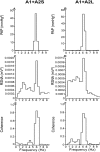Involvement of median preoptic nucleus and medullary noradrenergic neurons in cardiovascular and sympathetic responses of hemorrhagic rats
- PMID: 30050041
- PMCID: PMC6062576
- DOI: 10.1038/s41598-018-29310-z
Involvement of median preoptic nucleus and medullary noradrenergic neurons in cardiovascular and sympathetic responses of hemorrhagic rats
Abstract
The infusion of hypertonic saline solution (HSS) is known to be beneficial to the treatment of hypovolemic hemorrhage (HH). The central mechanism of HSS-induced cardiovascular and autonomic recovery of animals subjected to HH remains unclear. Hence, the present study evaluated the involvement of median preoptic nucleus (MnPO) and medullary noradrenergic neurons (A1 and A2) in HSS-induced cardiovascular and sympathetic responses in hemorrhagic rats. The wistar rats were subjected to specific lesion of noradrenergic neurons through the nanoinjections of anti-DβH-saporin into caudal ventrolateral medulla (A1 neurons) and nucleus of the solitary tract (A2 neurons). After recovery, mean arterial pressure (MAP) and renal sympathetic nervous activity were recorded. The HH was performed through blood withdrawal until a MAP of 60 mmHg was attained. In sham rats, HSS infusion (3M NaCl) reestablished MAP without change in HH-induced sympathoinhibition. The muscimol (agonist of GABAA receptor) was nanoinjected in MnPO during HH and MnPO inhibition abolished the recovery of MAP and HSS-induced sympathoinhibition. Simultaneous lesions of A1 and A2 abolished MAP restoration and sympathoinhibition after HSS infusion. These results suggest that the recovery of MAP and HSS-induced sympathoinhibition in hemorrhaged rats depend on intact neural projections from A1 and A2 to MnPO.
Conflict of interest statement
The authors declare no competing interests.
Figures








References
-
- Dilmen S, et al. Comparison of warm fluid and cold fluid resuscitation during uncontrolled hemorrhagic shock model in rats. Ulus. Travma Acil Cerrahi Derg. 2017;23:287–293. - PubMed
Publication types
MeSH terms
LinkOut - more resources
Full Text Sources
Other Literature Sources
Medical

